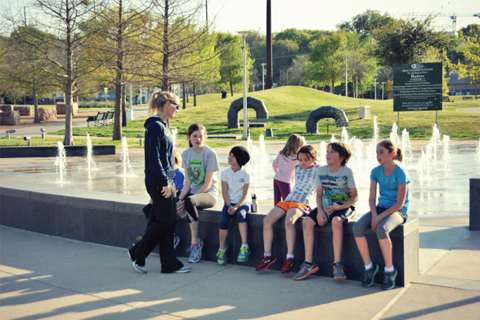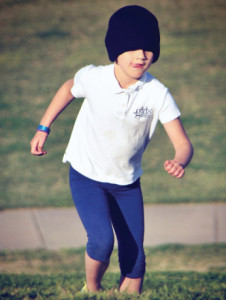Desiree Ficker Creates Fit Fickers

When I was a young kid, my dad, brothers, and I would awake at dawn on a school day just so we could arrive at the Potomac Falls public golf course before the first golfer teed off at 7 a.m. We would take our family dog, Sebastian, and run from tee to green over the nine-hole course. My youngest brother often got a head start, and the rest of our gang would try to catch him. We had all sorts of adventures on that golf course over the years, and I often arrived at school with grass stains on my shins. I don't recall feeling tired those mornings; if anything, I was a hyperactive kid who had a hard time sitting still in class. I can't imagine what school would have felt like if I had not gone running beforehand.
 Running in the morning is still a part of my daily routine. I don't feel as alert, healthy, or happy if my day starts without exercise. It makes me sad to see overweight kids today who are already too inactive to know what this difference feels like. Thanks to my family’s activity, I believe developing exercise routines early on sets the tone for a lifetime of overall physical fitness, while setting an early routine of inactivity is extremely damaging.
Running in the morning is still a part of my daily routine. I don't feel as alert, healthy, or happy if my day starts without exercise. It makes me sad to see overweight kids today who are already too inactive to know what this difference feels like. Thanks to my family’s activity, I believe developing exercise routines early on sets the tone for a lifetime of overall physical fitness, while setting an early routine of inactivity is extremely damaging.
According to the Mayo Clinic, childhood obesity has more than doubled in children and tripled in adolescents in the past 30 years. Children and adolescents who are overweight are likely to be obese as adults, therefore more at risk for adult health problems such as: heart disease, type 2 diabetes, stroke, several types of cancer, and osteoarthritis. One study showed that children who became obese, as early as age 2, were more likely to be obese as adults. As parents and teachers, what can we do? The simple answer is that we can help get these kids moving! Although I did not always love getting up at the crack of dawn and running, I believe that early encouragement set the stage for my intrinsic motivation to exercise.
 As a result of this belief, I have started a Fit Fickers running group for kids ages 6-15 (fitfickers.com; there are also summer triathlon camps for kids). We meet on Mondays and Wednesdays at Jack & Adams Bicycles; they’re kind enough to let us use the shop as a meeting place. This works out well for parents who can hop into the Jack & Adams free core class or go for a jog on Lady Bird Lake while their kids exercise. We head to the park next door for running drills, relays, and fartlek runs, where kids take turns yelling out answers to “your favorite part of spring break" or "your favorite thing about summer." I’ve noticed that, when the kids show up for workouts, they are often tired—sometimes even a little grouchy—after such a long day. Our jogs to the park are often the complete opposite of our jogs back; their moods and energy levels change almost as soon as we start moving. Stories spill out, the kids are laughing, and the group morphs into a bunch of rosy-cheeked, fit kids. I love seeing this transformation, and I am guessing this is what keeps them coming back for more.
As a result of this belief, I have started a Fit Fickers running group for kids ages 6-15 (fitfickers.com; there are also summer triathlon camps for kids). We meet on Mondays and Wednesdays at Jack & Adams Bicycles; they’re kind enough to let us use the shop as a meeting place. This works out well for parents who can hop into the Jack & Adams free core class or go for a jog on Lady Bird Lake while their kids exercise. We head to the park next door for running drills, relays, and fartlek runs, where kids take turns yelling out answers to “your favorite part of spring break" or "your favorite thing about summer." I’ve noticed that, when the kids show up for workouts, they are often tired—sometimes even a little grouchy—after such a long day. Our jogs to the park are often the complete opposite of our jogs back; their moods and energy levels change almost as soon as we start moving. Stories spill out, the kids are laughing, and the group morphs into a bunch of rosy-cheeked, fit kids. I love seeing this transformation, and I am guessing this is what keeps them coming back for more.
 Our bodies—young, old, and all ages in between—are meant to move. Why have kids stopped moving? The infrastructure of our society enables physical inactivity. We no longer want our kids to walk or bike to school because of safety and time constraints. Kids either take the bus or are driven short distances to school. Physical education in schools has been reduced or eliminated because of budget cuts, combined with a greater emphasis on academic performance. Video games and social media outlets encourage kids to stay inside and sedentary where snacking becomes much more of a focus. Our job as adults is to try to encourage the spread of physical activity in children along with growing their imagination involving the outdoors. We are responsible for setting boundaries on television, smart phones, and other video game devices.
Our bodies—young, old, and all ages in between—are meant to move. Why have kids stopped moving? The infrastructure of our society enables physical inactivity. We no longer want our kids to walk or bike to school because of safety and time constraints. Kids either take the bus or are driven short distances to school. Physical education in schools has been reduced or eliminated because of budget cuts, combined with a greater emphasis on academic performance. Video games and social media outlets encourage kids to stay inside and sedentary where snacking becomes much more of a focus. Our job as adults is to try to encourage the spread of physical activity in children along with growing their imagination involving the outdoors. We are responsible for setting boundaries on television, smart phones, and other video game devices.
Getting outside and out into nature is one of the most therapeutic mood enhancers you can get as a kid (or as an adult, for that matter). Please try to think about ways we can further help the kids in our families and in our communities to become more active. Maybe it's starting a kids’ running group, going for a family walk every evening, starting "carpooling" neighborhood walks to school as a chaperone, or even beginning the day with a family golf course run. Just remember to get out there early before the golfers start.






